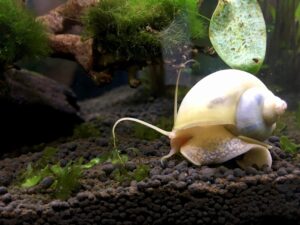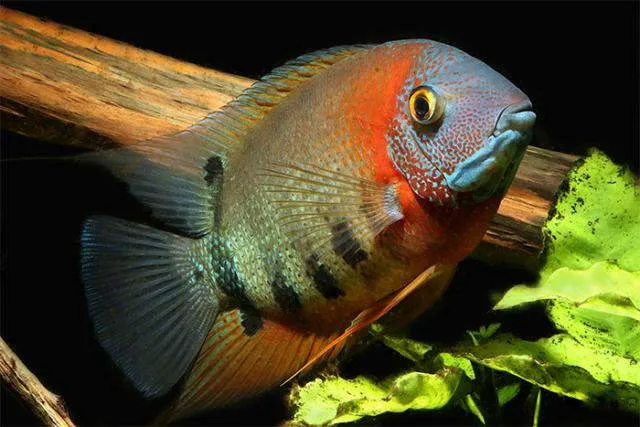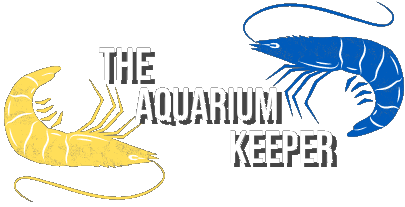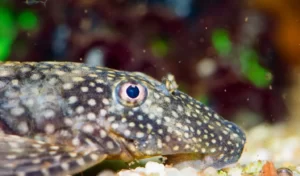
Red Shoulder Severum Care: Tank Setup, Diet & More

Writer at The Aquarium Keeper
There are many varieties of the famous severum, one of the most beautiful and desired is the red shoulder severum. These fish are uniquely beautiful with their shiny scales and deep red collar. This article will cover what you need to know about the red shoulder severum, including tank setup, care requirements, and more.
Species Overview
The red shoulder severum is an interesting south american cichlid species, that can easily be a centerpiece in most aquarium tanks. Here is a brief overview of these species:
| Aspect | Information |
|---|---|
| Scientific Name | Heros sp. Rotkeil |
| Origin | North America, Amazon and Negro rivers |
| Water Temperature | 22°C to 29°C (72°F to 84°F) |
| pH | 6.5 – 7.5 |
| Size | 7-10 inches (18-25cm) |
| Temperament | Generally peaceful, but can be territorial |
| Diet | Omnivorous (small fish, crustaceans, plant matter, bloodworms) |
| Tank Size | 50 gallons for 1 fish |
| Care Level | Intermediate |
Origin
To masterfully keep fish in our aquariums, we must know the origin of the species so we know its specific needs and requirements. Although not yet studied in depth by science, it is believed that the red shoulder severum is a geographical variation of the fish known as Heros cf. efasciatus. This species has a wide range, being present in most places in Amazon and Negro Rivers basin in South America, being a part of the diet of the people who live there.
Because the habitat of this fish is a very large area, there are many varieties and colors of these species. Therefore, the Red shoulder severum occurs only in a specific region of the Peruvian Amazon, being collected near the city of Iquitos, one of the world’s largest collection and export centers of ornamental fish.
Natural Habitat
Red shoulder severum occurs in several habitats. These fish live in acidic soft waters, often dark due to the amount of organic matter or muddy due to small particles. Those varied habitats go from shallow places, such as ponds and flooded forest areas, to deeper rivers.
A characteristic of these habitats is the calm flow and the abundant presence of trunks and leaves on the substrate. Severum habitat experiences extreme seasonal fluctuations, so the adaptability of these fish to different water conditions is remarkable.
Appearance
Red shoulder severum are very colorful fish with a stunning appearance. These severum display the body in the peculiar shape of the cichlids, an elegant oval shape, a robust and rounded profile.

Its scales are well-marked and fit together harmoniously, showing a beautiful iridescence. The fins are well developed, highlighting its beautiful dorsal fin, which can expand beyond the fish’s tail.
Colors And Markings
This fish has the outstanding characteristic of having a beautiful intense red mark behind the gills. The popular name “red shoulder” is due to this distinctive feature. They present a highly iridescent face in green and bluish tones with dark reticulated spots on the cheeks.
On the body they have some dark spots and perpendicular bars; the last one, close to the base of the tail, is very well marked. The body is colored in tones that vary from golden to greenish. It is a beautiful fish, with vivid, bright, and contrasting colors.
Size
Red shoulder severum are medium to large cichlids, reaching sizes of around 7-10 inches (18-25cm) in length. Its growth is fast while juvenile, decreasing as it reaches adulthood. These species are not considered dwarf cichlids, and need larger tanks to fully thrive.
Camouflage
The coloration and body structure of these tropical fish have practical functions. Their coloration helps camouflage them, providing an advantage in feeding or fleeing predators. Its body shape helps it maneuver between logs, leaves, and swampy forests.
Behavior
As much as each fish has its individuality, some behaviors are characteristic of the species. Red shoulder severum are relatively peaceful among conspecifics and with other species. Aggression can still occur, but among cichlids, these are calm-tempered fish. Keep in mind that individual variations exist, and some fish may show a greater degree of territorialism and aggression.

When interacting with fish with similar behavior, the red shoulder severum is calm and curious. This makes them great members of community aquariums, as long as we choose carefully the inhabitants.
Red shoulder severum are diurnal fish, feeding and exploring through the hours of light. They are active and extremely curious species who will always investigate what is happening in the aquarium and the surrounding environment.
Tank Setup
As hardy and adaptable to the environment as these fish are, we must create a specific environment to meet their needs. Imitating as much as possible severum habitat conditions is a good starting point.
Aquarium Size
Severum are fish of considerable size and active habits. When designing a tank for this cichlid, think about large spaces. Use a tank of at least 190 liters (50 gallons) to hold an individual, 60 gallons (220 liters) for a couple. In the case of a group, count 20 gallons for each individual.
Cichlids are known to eat a lot and produce a lot of waste. The larger the aquarium volume, in addition to providing a larger environment for the fish to explore, helps maintain the system’s stability.
Decorations
Fish that live in forest environments and dark water, when in an aquarium, appreciate quiet places with many hiding places. In addition, severum is a fish that naturally lives close to the substrate, so we must create areas of refuge using decorations such as driftwood, roots, and rocks.
We can also use artificial decorations as long as they are suitable for use in an aquarium. Decorative elements have an aesthetic function in domestic aquariums. Live plants are more beneficial, but the red shoulder severum love to nibble and uproot plants. If you want live plants, be sure to use column-feeding aquarium plants, that don’t need to be planted to thrive, they are also generally more hardy.
Biotope Aquarium Style
Red shoulder severum is a very used species and can often be included in biotope aquariums of species, that also live in the same region as the red should severum. Biotope aquariums mimic the conditions and aesthetics of the geographical location where these fish come from.

They are complex projects which involve a lot of research and dedication to identically replicate characteristics such as the substrate, the species that make up the vegetation, the types of rock, and everything else. In these aquariums, the fish feel incredibly comfortable, being the maximum welfare that we can provide.
Substrate
We should always use soft and sandy substrates, free of sharp edges. Red shoulder severum, like other cichlids, like to forage in and on the substrate. Non-soft surfaces, like sharp gravel, will hurt the fish’s mouth.
You might also like to read: How to Choose the Best Substrate for Aquarium? Aquasoil, Sand & More
Water Conditions
These beautiful cichlids inhabit ever-changing tropical regions due to seasonal fluctuations in floods and droughts. These fluctuations make them known for their adaptability to different aquatic conditions.

Even being adaptable to different water chemistry, these fish are incredibly susceptible to water quality. They will hardly develop in poor-quality water, with pollutants or non-ideal parameters.
Keeping water conditions stable is the primary job of every fishkeeper. We must always use a reliable thermometer and test kit to see if parameters such as temperature, pH, hardness, ammonia, and others are stable and within the recommended range for red shoulder severum. We must perform partial water changes and substrate siphoning weekly, and perform deeper cleaning (involving the filtration system and decorations) monthly.
Water Temperature
When designing the future aquarium for the red shoulder severum, it is essential to replicate the tropical temperature of the place these fish inhabit.
These fish thrive optimally in a temperature range between 22°C to 29°C (72°F to 84°F). As much as in nature the variation can occur in a short period, in the aquarium, the temperature must remain stable, to stabilize the temperature, we use a heater with a thermostat.
pH And Water Hardness
pH and hardness are factors to check (and adjust) routinely, as they are crucial to creating an ideal environment for severum. The ideal pH for these fish is always acidic, between 6 and 7. The water hardness must be low, between 1 and 8°.
Diet
If everything in the aquarium is ideal it is unlikely that the red shoulder severum will have problems feeding, which is a fish that is always hungry. In their natural environment, severum feed on a wide range of foods. Biofilm, larvae, aquatic insects, vegetable matter, and small fish are some foods that make up their diet.
In an aquarium, they will immediately accept all types of food available, such as live, fresh, and dry. Some newly collected individuals may take longer to acclimate to dry or inert food. The best approach is to use bloodworms, earthworms, etc, as snacks throughout the day. Feed the fish at least twice daily in quantities to be entirely consumed. Variety is the key to an ideal, balanced diet.
Common Diseases
Like other tropical cichlids, red shoulder severum are known for their hardiness and resistance to disease. They are susceptible to diseases when exposed to poor water quality or stress. Keeping the water in the tank always in perfect condition is essential.
When exposed to a sub-optimal environment with pollutants such as ammonia, fish suffering from aggression, or irregular parameters, the red shoulder can suffer from problems such as holes in the head, ich, dropsy, and popeye (exophthalmia).
Good Tank Mates
Choosing good tank mates is critical to a harmonious environment and keeping your fish stress-free. We should always select fish with similar size and behavior characteristics to the red shoulder severum, thus minimizing conflicts.
Fish with the same size as severum are more likely to interact peacefully and resist occasional aggression. The tank mate temperament must be studied beforehand, as red shoulder can suffer aggression from bigger and more territorial fish. Here is a list of potential good tank mates for the red shoulder severum:
- South American Cichlids: We find good options for tank mates in the same scientific family that the severum. Species such as some Geophagus and chocolate cichlid are good choices and share the same habitat as the severum.
- Schooling fish: Some large schooling fish like tinfoil barb and rainbow fish are great additions to the tank, creating incredible looks. Characins such as red hooks are peaceful and coexist well with severus. The movements in shoals and the vibrant colors of these fish bring dynamism to the aquarium.
- Bottom-dwellers: Corydoras and plecos are welcome additions to a red shoulder severum tank. We must avoid using small Corydoras species, as they could be a snack for severum. Plecos are great options, as well as being available in a variety of species.
Always make sure to monitor, how your newly added tank mates interact with the red shoulder severum. If you see any problems or aggression, be sure to rehome the problem causer, so that it does not injure other fish.
You might also like to read: 11 Types Of Ram Cichlids You Should Have
Bad Tank Mates
We must avoid bad tank mates – fish that can create conflicts, destabilize the aquarium, and generate stress for the red shoulder severum. Here are certain fish, that you shouldn’t house with the red shoulder severum:
- Small fish: One of the considerations when choosing tankmates is the size of the fish. Very small fish such as guppies and tetras will become easy prey and should be avoided.
- Aggressive fish: When choosing tankmates, we should always think about whether they will compete for food or territory. Aggressive cichlids at the time of feeding such as the peacock bass will scare and inhibit the feeding of the severum.
Breeding
Red shoulder severum reproduces easily, as long as the water is in good condition, and spontaneous and successive reproductions may occur in a domestic aquarium.
Difference Between Sexes
The differentiation between the sexes is made visually, with the male having more vibrant colors, and a larger size and length of fins, mainly the dorsal one. If growing in a group, couples can be seen as they reach sexual maturity by exhibiting typical cichlid behaviors. During the mating season, the structure called the ovipositor is visible in the female’s belly.
Ideal Conditions For Breeding
To ensure reproduction takes place, there are some steps we can create to trigger reproductive behavior in severum. We must recreate the conditions caused by the flood period in the natural environment. This includes conditioning the animals with plenty of live food and providing constant optimal water quality.
Reproductive Behaviors
These fish are monogamous cichlids, forming stable pairs during the breeding season. The courtship ritual is typical of cichlids, marked by graceful movements and displays of vibrant colors. Couples can clean a chosen place for spawning, such as a rock or a flat surface, where the eggs will be deposited.
This is a species that exhibits parental care, which means that the parents take care of the eggs and larvae for some time. Both parents care for the eggs, keeping them oxygenated, keeping predators away, and removing fungus-contaminated eggs. Eggs hatch in 3 to 5 days.
Frequently Asked Questions
Are The Red Neck Severum The Same as Red Shoulder Severum?
These two names are complete synonyms for the Heros sp. Rotkeil fish. Some people sell these species under one or the other common name that they are known for.
Is The Red Shoulder Severum Aggressive?
Aggression is possible when it comes to the red shoulder severum, but it is very unlikely since it is a relatively peaceful fish. Nevertheless, it is a cichlid, and cichlids are often very territorial and can occasionally fight.
Writer's Thoughts
The red shoulder severum is an interesting species, that require some extensive knowledge before keeping. I hope this care guide will provide you with that knowledge, and that you have luck in taking care of this magnificent fish.
If you enjoyed reading our article, please feel free to share it with your friends by clicking the social media buttons below:





